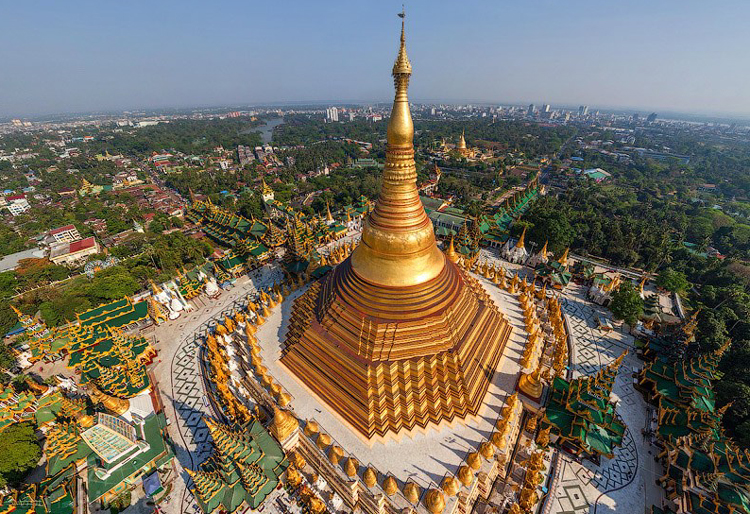

 |

|

|
According to legend, the Shwedagon Pagoda has existed for more than
2,600 years, making it the oldest historical pagoda in Burma and the world.
According to tradition, two merchant brothers, Taphussa and Bhallika,
from the land of Ramanya, met the Lord Gautama Buddha during his lifetime
and received eight of the Buddha's hairs in BC 588. The brothers traveled
back to their homeland in Burma and, with the help of the local ruler,
King Okkalapa of Burma, found Singuttara Hill, where relics of other Buddhas
preceding Gautama Buddha had been enshrined. When the king opened the
golden casket in which the brothers had carried the hairs, incredible
things happened:“ There was a tumult among men and spirits ... rays emitted by the Hairs penetrated up to the heavens above and down to hell ... the blind beheld objects ... the deaf heard sounds ... the dumb spoke distinctly ... the earth quaked ... the winds of the ocean blew ... Mount Meru shook ... lightning flashed ... gems rained down until they were knee deep ... all trees of the Himalayas, though not in season, bore blossoms and fruit.” According to some historians and archaeologists, however, the pagoda was built by the Mon people between the 6th and 10th centuries CE. The stupa, a mound-like structure containing Buddhist relics, fell into disrepair until the 14th century, when the Mon king Binnya U of Bago had the stupa rebuilt to a height of 59 feet. A century later, Queen Shinsawbu, Dhammazedi's mother-in-law, raised its height to 131 feet. She terraced the hill on which it stands, paved the top terrace with flagstones, and assigned land and hereditary slaves for its maintenance. She yielded up the throne to Dhammazedi in 1472, retiring to Dagon; during her last illness she had her bed placed so that she could rest her dying eyes upon the gilded dome of the sacred fane. The Mon face of the Shwe Dagon inscription catalogues a list of repairs beginning in 1436 and finishing during Dhammazedi's reign. It mentions Queen Shinsawbu under a Pali name of sixty-six letters. By the beginning of the 16th century the pagoda had become the most famous place of pilgrimage in Burma. A series of earthquakes during the next centuries caused damage. The worst damage came from a 1768 earthquake that brought down the top of the stupa, but afterward King Hsinbyushin (Lord of the White Elephant) of Konbaung Dynasty raised it to its current height of 325 feet. A new crown umbrella called hti was donated by King Mindon Min in 1871 after the annexation of Lower Burma by the British. The pagoda is listed on the Yangon City Heritage List. From February 22, 2012 to March 7, 2012, devotees celebrated the annual Shwedagon Pagoda Festival for the first time since 1988, when it was banned by the governing State Law and Order Restoration Council. Celebrations began at the Rahu corner of the pagoda's yinbyin platform, at the Maha Pahtan and Aung Myay central platforms, at 9 am. on February 22. The Shwedagon Pagoda Festival, which is the largest pagoda festival in the country, begins during the new moon of the month of Tabaung in the traditional Burmese calendar and continues until the full moon. |
CAN'T FIND WHAT YOU'RE LOOKING FOR? CLICK HERE!!!